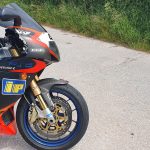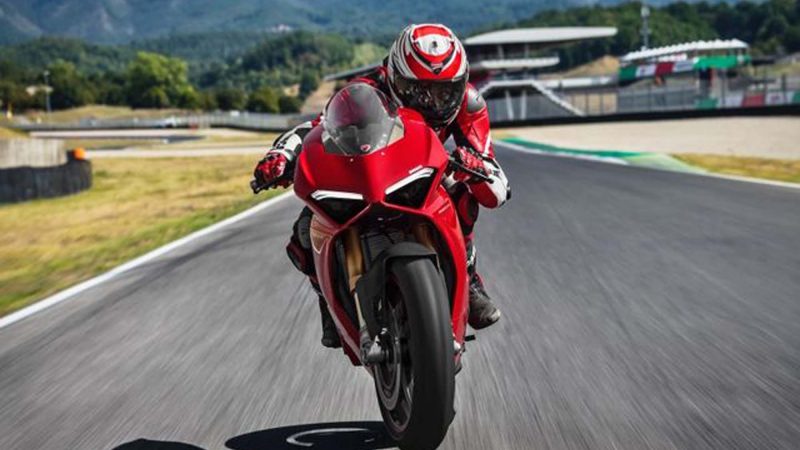Used Bike Review: Aprilia RSV Mille R (1999 – 2003)

Aprilia RSV Mille R Review
Two stroke handling with V-Twin power…
Today was a good day…the day I finally got the opportunity to be hands on with one of my all time favourite bikes, it’s a 2002 Aprilia RSV Mille R. It’s funny to call it a favourite bike as this was actually my first time riding this specific shape RSV, but I’ve been lucky enough to have had a fair few two stroke Aprilia race bikes in my time and some of my best biking memories have been on those bikes, obviously those old Aprilia RS machines share the shame shape as this…so this bike has always felt very familiar to me.
So, a little history about the bike. When Aprilia first announced in the late 90’s that they were to produce a fully fledged superbike, it caught the worlds attention. After winning multiple championships in the 125 and 250cc classes and introducing the world to riders such as Max Biaggi and Valentino Rossi, there was no doubt that Aprilia knew what they were doing when it came to racing. The big question was, what could they do with their first attempt at making a superbike?
In 1999 the RSV broke cover and instantly became competition for Ducati. In 2001 the RSV was revised with over 200 minor tweaks and improvements from the original bike. The bike was further tweaked again in 2003. The RSV was offered in three variants, the base model RSV Mille, The RSV Mille R like I rode for this review, this features full Ohlins, Aluminium forged wheels, it’s single seat only and is dressed with lots of carbon fibre. The final variant is the RSV SP which was the ultimate spec RSV, it features things like an adjustable frame, full ohlins, carbon fairings and an alloy tank…it also came with a £23,000 price tag which was a phenomenal amount of money for a bike 20 years ago.
RSV Mille R or RSVR?
Now I do sometimes see some confusion between the Mille R like is featured in the review and the Aprilia RSVR or RSV100R that I reviewed last year. So, from 1998 to 2003, the RSV was the base model and the RSV-R signified the higher spec version, like we have here. From 2004 onwards the RSVR became the base model, with the RSVR Factory being the better specced bike.
The bike:
At the heart of the bike is the 998cc 60 degree V-Twin engine which was developed and manufactured by Rotax and produces just shy of 130 BHP, which is not crazy by todays standard but 20 years ago this was seriously impressive. Outsourcing the engine allowed Aprilia to concentrate on what they do best, which was creating a winning chassis. Many reviewers at the time commented that the RSV handled like a much smaller machine. For suspension, we have full Ohlins front and rear which are all fully adjustable as you would expect. For slowing you down, the R model is equipped with dual 320mm discs up front with 4 piston calipers from Brembo.
Now, the more observant of you will notice that this isn’t a standard RSV Mille R. Aprilia produced 300 limited edition Noriyuki Haga replicas which featured various goodies, most noticeably the replica bodywork, a full Akraprovic titanium exhaust and a different injection unit that was mapped for the Akra system. Sadly, this isn’t one of those limited edition bikes but it does sport the Haga bodywork and the single Akra can…being that those 300 bikes are super elusive today, tso you’ll need to be pretty fortunate to get the opportunity to buy one and it will likely be for a fair amount more money than a standard RSVR…so for most of us, this is the next best thing
On the road:
From the moment you throw your leg over the bike its clear it isn’t a bike for the inexperienced. With your weight on the bike the suspension barely compresses at all, the foot pegs are high, the bars are forward and low. After personally owning a Gen 2 shape RSVR, I had already made some preconceptions of what this was going to be like.
But, I was totally wrong.
Amazingly the Mille R feels like a totally different bike to its successor. The clutch is fairly light, the bike feels very easy to maneuver around even at slower speeds. The thing that surprised me the most was the gentle click into neutral. My RSVR takes a degree in physics to understand how to find neutral, especially from a stand still.
Getting going is when the Mille R really shines. The low end torque is just about as intoxicating as the noise it makes. Tipping in and out of corners feels like your riding a 600 and winding on the power on your way out said corner is sure to put a big smile on your face.
Many times throughout the day I had to stop and remind myself that this bike is now almost 20 years old. The right rider with the bike setup properly would give plenty of newer model superbikes a run for their money on a track day.
Conclusion:
After spending the day with the bike if I’m honest there wasn’t anything I didn’t like about it….it’s not massively comfortable, its a bit of a pain in the ass going through towns…but these little quirks only add to its charm. Old italian bikes do come with a bit of a stigma attached when it comes to reliability, but personally I think it’s little unfair. One of the RSV’s biggest issues is the electrics, the stock battery is too small for the big twin, the electrics can be temperamental if its very wet or very cold, the fork seals have been known to start leaking and the rear suspension linkage can be a bit iffy…but these are all things that for the most part are easily sorted out. In truth, it might not be as dependable as a japanese inline four, but that doesn’t mean it’s unreliable by any stretch of the imagination. If you’ve ever owned an Italian superbike you’ll likely know exactly what I mean.
The good points? Well, the RSV is quickly becoming a classic bike…I know Bennets insurance class anything over 14 years old as eligible for classic insurance. I would imagine the value of these bikes will only increase over the coming years too. The bike just oozes character and, in my opinion, is an absolute work of art. Being Aprilias first superbike which led the way to the RSVR and the now RSV4, it will always be held in high regard amongst enthusiasts and collectors.

Would I recommend one? Absolutely! You’ll find an old Aprilia, either this shape or a gen 2 shape, cheaper to buy and cheaper to run than an equivalent Ducati from the same era.
Huge thankyou to JD Motors / JD Comps for loaning us the bike for the day.
Ratings:
The Rotax 60 degree twin is a bullet proof and reliable engine. The dry sump will ensure constant lubrication and you’ll find it generally easy to work on.
Fully adjustable forks, rear shock and steering damper. It is certainly very hard if riding on bad roads but is near perfect on the track or smooth A road.
The rear brake feels quite underpowered, but fortunately the front Brembo’s are fantastic and give the big strong and progressive stopping power.
Great build quality and attention to detail throughout, as you would expect on an Italian bike The welding work is all well worth admiring.
The looks, the performance and something a little different from everyone else. Fairly cheap to pick up and maintain. Highly recommended.



























